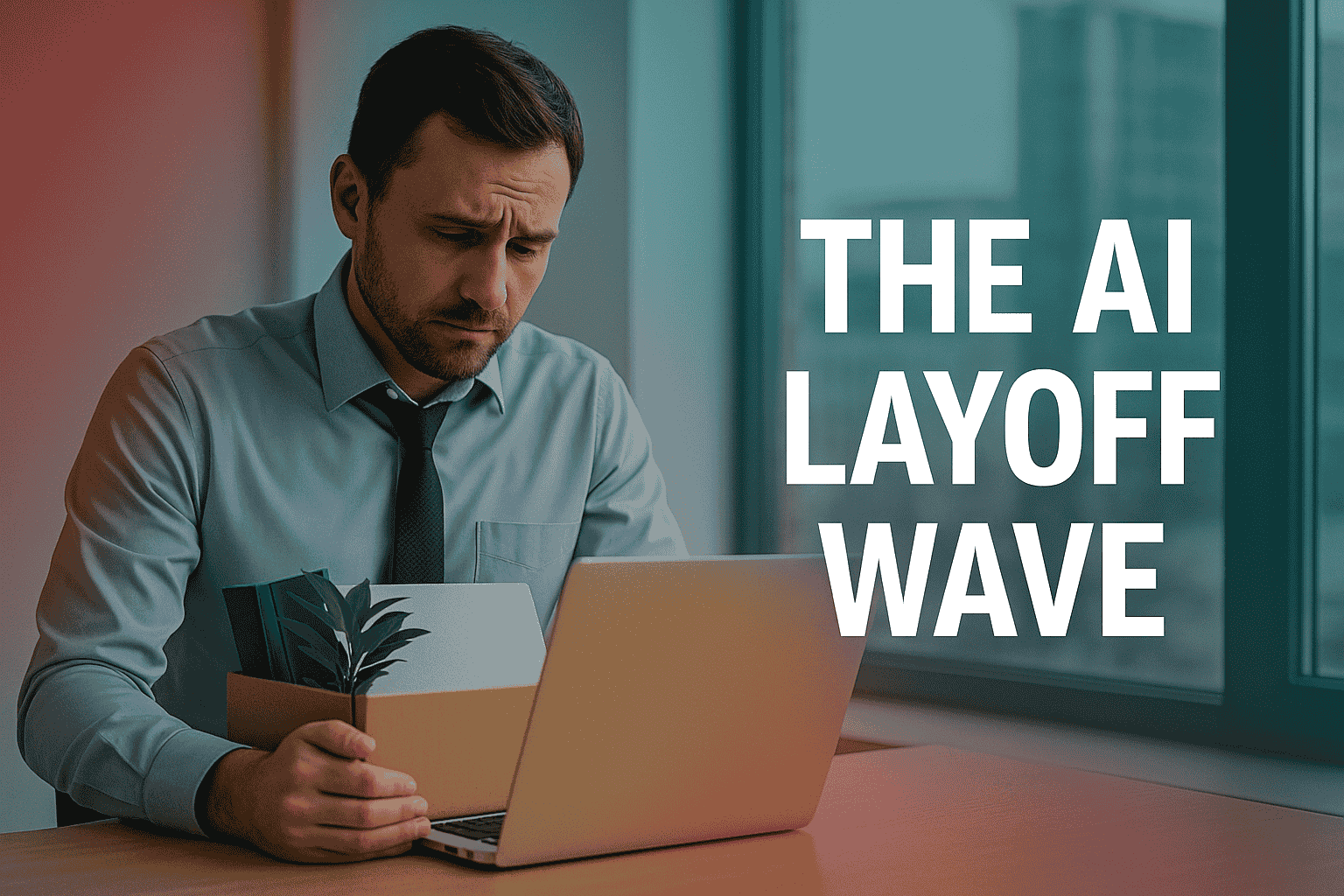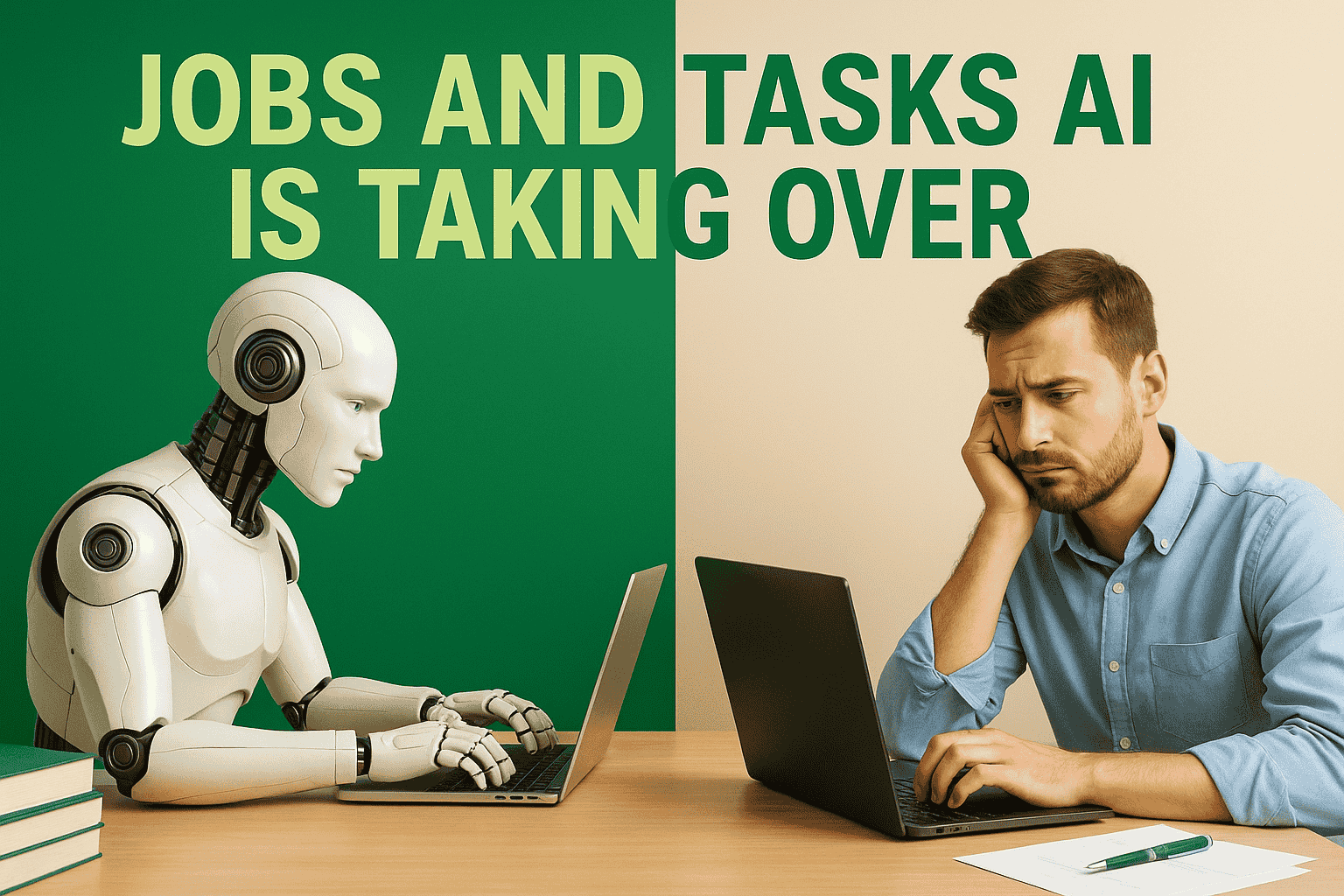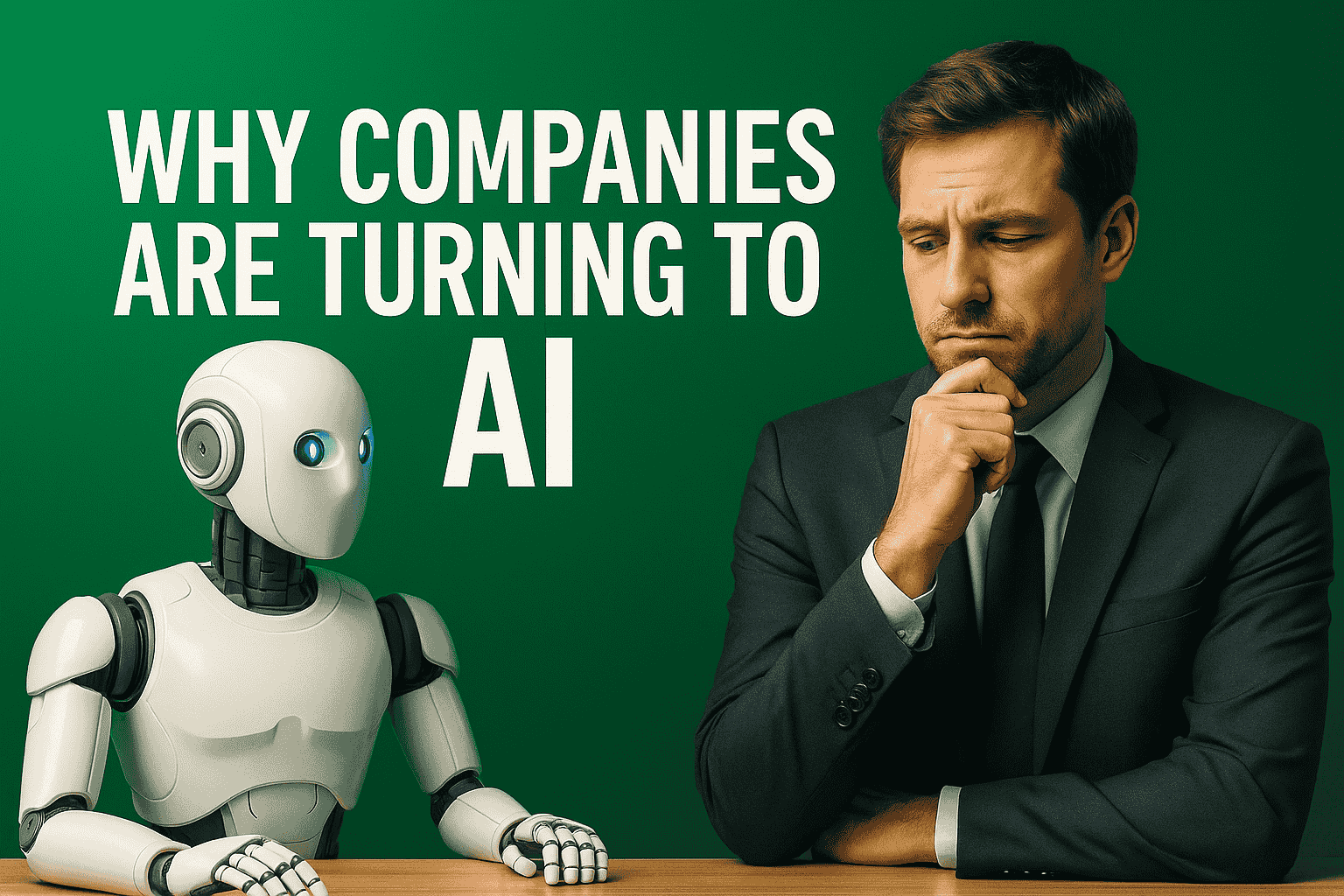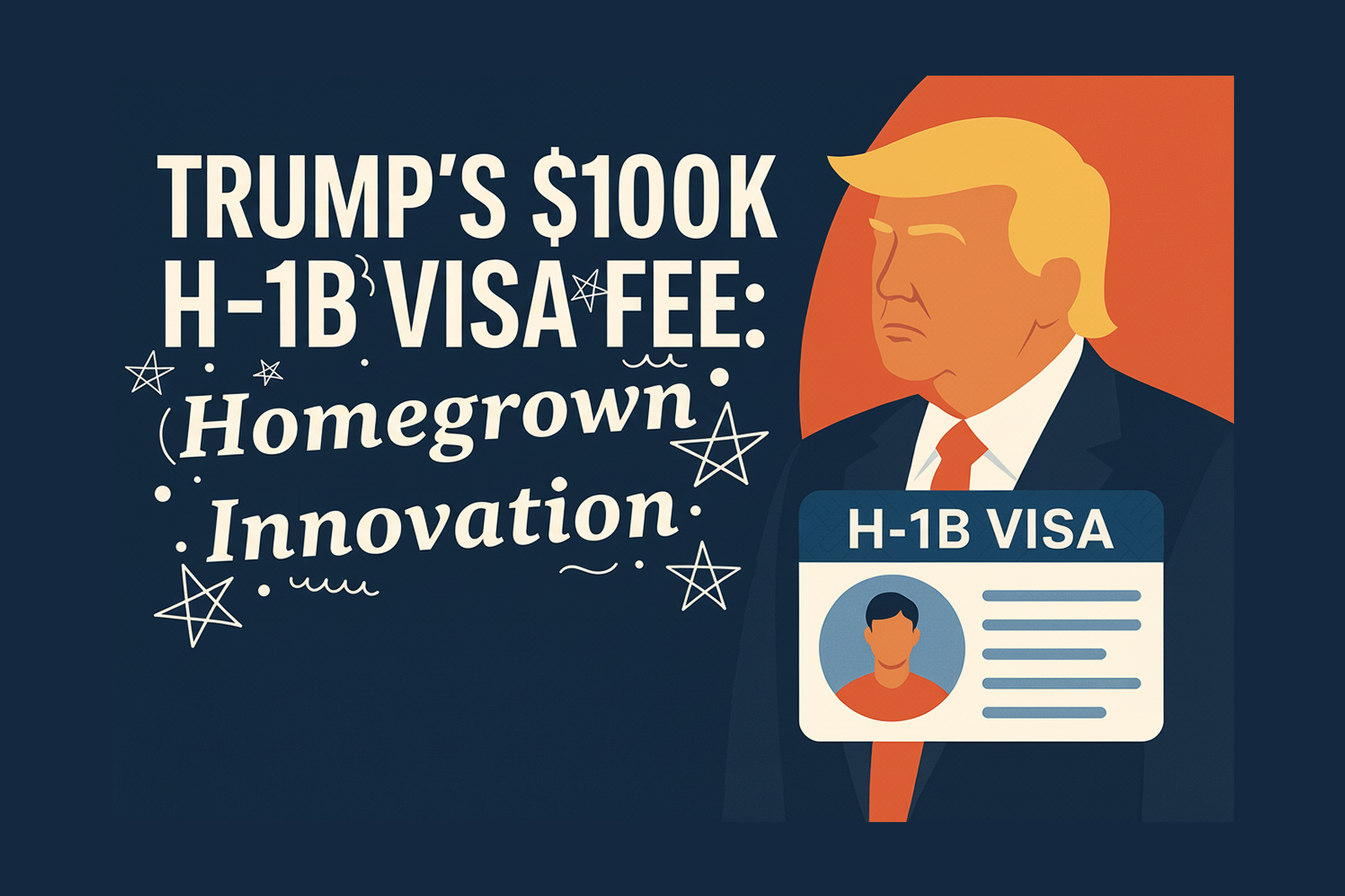The AI Layoff Wave: Who’s Safe, Who’s Not
Amazon’s latest announcement sent shockwaves through the tech world: the company is laying off thousands of corporate workers, despite booming profits
Prefer watching over reading?
Watch our podcast below:
listen to our podcast below:

Not long ago, the idea of AI causing mass layoffs felt like science fiction. Now, it’s happening in real time. Salesforce, a leader in software, recently revealed it cut 4,000 customer support jobs because AI chatbots can handle half of all customer interactions. CEO Marc Benioff bluntly stated, “I’ve reduced [support staff] from 9,000 heads to about 5,000, because I need less heads,” noting that 50% of customer queries are now resolved by AI agents instead of humans. In education, Chegg — an online learning platform — announced it had slashed 45% of its workforce (388 employees) after new AI tools like ChatGPT drove students away from its services Chegg is now pivoting to an AI-powered model where an algorithm answers student questions automatically at a “substantially lower cost”
-png.png?width=1980&height=1182&name=output%20(5)-png.png)
In plain English: nearly a third of what American workers do today might be done by machines within a decade.
-png.png?width=1979&height=1180&name=output%20(6)-png.png)

- Customer Service & Call Centers: One of the first areas hit by AI automation is customer support. Intelligent chatbots and voice assistants can resolve common inquiries 24/7 without breaks. At Salesforce, for example, AI “agents” now handle half of all support interactions, allowing the company to eliminate thousands of human support roles. The tasks at risk include answering FAQs, processing simple requests, and troubleshooting basic issues. AI can field these queries instantly and simultaneously, whereas a human agent can only handle one call or chat at a time. The result is huge efficiency gains – and fewer customer service reps on the payroll.
- Middle Management & Analysts: A surprising target of this AI wave is middle management and analytical roles. These jobs often involve coordinating projects, preparing reports, and making routine decisions based on data – tasks that advanced AI can perform at lightning speed. Amazon’s restructuring is a prime example: the company believes generative AI can take over many “coordination, reporting, and decision-making functions” that managers used to do.
Instead of dozens of people compiling data and status updates, an AI system can instantly pull information from across the organization and generate reports or recommendations. By automating intelligence, companies like Amazon aim to streamline operations and cut out layers of managers
In fact, Amazon’s CEO said as they adopt AI, they will need “fewer people doing some of the jobs that are being done today”
The jobs being trimmed here include project coordinators, report writers, and mid-level supervisors – roles that are about processing information and routing decisions. AI algorithms, armed with vast data and analytical prowess, are doing this work more efficiently and without bias or fatigue.
From frontline sales to analytics: One AT&T retail salesman watched AI chip away at cold-call grind and manual performance tracking. He chose to reskill. After a focused year, he moved into analytics and broke into six-figure territory—trading repetitive call sheets for building data workflows and BI logic.
Administrative & Back-Office Roles: Another category squarely in AI’s sights is repetitive office work – think data entry, scheduling, bookkeeping, and basic HR tasks. AI-driven software (from OCR document readers to intelligent scheduling assistants) can handle many back-office processes without human intervention. IBM’s CEO recently revealed a plan to pause hiring for roles that could be done by AI – roughly 7,800 jobs, mainly in non-customer-facing functions like HR.
He estimates that 30% of such back-office roles could be replaced by AI within 5 years.
These include tasks like screening resumes, processing invoices, generating routine reports, or managing calendars. The efficiency case is clear: an AI doesn’t get tired or make typos, and it can run through databases or forms far faster than a person. So we’re seeing companies from banks to hospitals adopt AI for things like payroll processing, expense approvals, and record-keeping – reducing the need for large administrative staffs.
Manufacturing and Retail Automation: (It’s worth noting that while our focus is on U.S. white-collar layoffs, automation is also changing blue-collar jobs.) Robots and AI-powered machines are increasingly present on factory floors and in stores. Self-checkout kiosks and automated inventory systems mean retailers can operate with fewer cashiers and stock clerks.
The initial wave of AI-driven layoffs has hit offices before factories, but as technology advances, roles like assembly line inspectors, forklift operators (hello, self-driving forklifts), and even delivery drivers (with autonomous vehicles) could face cuts. The key distinction: physical jobs often require dexterity and adaptability that AI and robots are still developing, so those roles have a bit more cushion – for now. But the long-term trend is clear across industries: any task that can be automated, will be.
High-skill roles (like AI engineers or strategists) remain in demand, and many low-skill manual jobs (like janitorial work or food prep) still require human labor. It’s the vast middle – customer service reps, administrative coordinators, entry-level analysts where AI is making the fastest inroads. This middle segment is where a lot of Americans have traditionally built careers, which makes the current AI-driven layoffs especially concerning.

- Speed and Scale: AI systems process data and perform calculations at speeds no human can match. A chatbot can engage thousands of customers at once, providing instant answers. A data-analysis AI can crunch a million records in minutes to find patterns. This means tasks that used to take an entire team weeks – compiling sales figures, answering support emails, reviewing documents – might be done in a blink. For example, an e-commerce startup that replaced 90% of its support staff with a chatbot boasted that their response time went from over 1 minute to instant, and problem resolution dropped from 2 hours to just a few minutes (a dramatic illustration of AI’s speed advantage). When companies see those metrics, it’s a strong incentive to automate.
- 24/7 Consistency: Unlike humans, AI doesn’t sleep, get sick, or have off days. It provides consistent output around the clock. This is gold for customer-facing services – no more night shift staffing, no gaps on weekends. For tasks like network monitoring or security surveillance, AI never blinks. That consistency can also improve quality: a machine learning model checking loan applications won’t zone out and miss a red flag the way an overworked employee might.
- Lower Costs (After Initial Investment): There’s an upfront cost to developing or implementing AI solutions, but once in place, they often have a low marginal cost. Software doesn’t draw a salary or benefits. If an AI tool allows a company to serve customers or produce output with fewer employees, that translates directly to cost savings. In an uncertain economy, many CEOs see automation as a way to trim budgets. In fact, in the survey mentioned earlier, business leaders cited economic pressure and AI as twin drivers of why they’re cutting jobs or freezing hiring. Layoffs are never easy, but when a company must tighten its belt, having an AI alternative makes the decision to eliminate roles slightly less daunting from a business standpoint.
- Data-Driven Accuracy: In domains where decisions are made by analyzing data (think finance, logistics, marketing), AI can often make more data-informed choices than a human who might go by intuition or limited experience. An AI trained on vast datasets can predict customer behavior or optimize a supply chain route with a precision humans can’t easily attain. This reduces errors and can increase revenue, which again pressures companies to adopt AI in decision-making roles (hitting jobs like market researchers or junior financial analysts).
That said, AI isn’t infallible. There have been plenty of instances of chatbots giving wrong answers, or automated systems going haywire without human oversight. Smart companies recognize AI as a tool to augment human work in many cases, not just replace it. But in roles where the tool is clearly capable, the replacements are happening fast.
Adaptation, Not Doom: New Jobs Emerging (and Why Humans Still Matter)
-png.png?width=1536&height=1024&name=ChatGPT%20Image%20Nov%205%2c%202025%2c%2011_19_21%20PM%20(1)-png.png)
So what are these new opportunities, and how can displaced workers take advantage?
- New AI-Centric Roles: As routine tasks become automated, entirely new categories of work are growing. We’re already seeing job postings for things like AI prompt engineers (people who fine-tune the questions and commands given to AI systems), AI model trainers, data ethicists, and automation supervisors. A recent report noted that the job market will shift toward roles focused on “AI oversight, data ethics, prompt engineering, and human-AI collaboration.”
These are jobs where humans ensure AI is functioning correctly, ethically, and effectively. For instance, every company implementing chatbots needs someone to train the bot, feed it the right knowledge base, and monitor its responses for quality – that’s a human job. Similarly, if AI is analyzing medical images, there’s a need for specialists to verify results and handle edge cases. In other words, AI may do the heavy lifting, but humans are needed to build, guide, and audit the AI. - Augmented Roles, Not Eliminated Ones: In many professions, AI is becoming a collaborative tool rather than a replacement. Take engineers and developers: coding assistants powered by AI (like GitHub’s Copilot) can generate boilerplate code or debug suggestions, which means a single developer can be far more productive. This doesn’t eliminate the developer’s job – it amplifies it. We’re seeing similar effects in law (AI tools that do legal research, letting lawyers focus on strategy), medicine (AI that analyzes scans so radiologists can focus on nuanced diagnoses), and design (AI that drafts design options which designers refine).
The key is that people who know how to leverage AI will excel. Employers are starting to prefer candidates who can work alongside AI tools. In a survey, tech leaders said workers without AI skills are at higher risk of layoffs whereas those who embrace AI are more likely to be retained and promoted. So, the nature of many jobs is evolving: the mundane 50% of your job might be done by AI, but that frees you to focus on the creative or complex 50%. Employees who adapt to this “AI + human” mode can become more valuable, not less. - Human Skills in Demand: Ironically, as AI handles more rote work, human soft skills become even more important. Abilities like creative thinking, problem-solving, leadership, and emotional intelligence are hard to code into a machine. Companies will always need managers who inspire teams, salespeople who build relationships, and creatives who dream up big ideas for campaigns or products. AI can crunch numbers and spit out a trend, but it takes a person to decide what that trend means for strategy or to empathize with a client’s unique needs.
Forward-looking businesses know that a balanced workforce of humans + AI is ideal – AI for efficiency, humans for empathy and ingenuity. As one career expert put it, “adaptability and critical thinking will differentiate top talent in the future, even as digital skills are essential.” So if you’re worried about a robot taking your job, a good plan is to double-down on the uniquely human aspects of your role, while also upskilling in tech so you can supervise or work with those robots.
-png.png?width=1536&height=1024&name=ChatGPT%20Image%20Nov%206%2c%202025%2c%2005_45_05%20PM%20(1)-png.png)
Education and training are key. Luckily, we live in a time where learning new tech skills is more accessible than ever. Bootcamps, online courses, and specialized programs can take you from novice to proficient in months, not years. One such pathway is through Colaberry’s School of Data Analytics and AI, which has become a proven springboard for career changers. (We mention Colaberry here because it’s focused exactly on this mission – helping people transition into data and AI careers).
Colaberry’s programs are designed to empower career transformations. You don’t need a prior IT background – they’ve helped teachers, veterans, artists, and folks from all walks of life pivot into tech. How? By offering hands-on, practical training in data analytics, data science, and AI, coupled with the crucial “soft skills” like communication and problem-solving.
In as little as 12 weeks, you can learn to become a data analyst, capable of deriving insights from data and building dashboards to tell compelling stories. Or you might dive into a 20-week data science and machine learning program to learn how to build predictive models and AI algorithms. These aren’t fluffy courses – they involve real projects and mentorship, so you graduate with experience under your belt.
“I was a correctional officer living paycheck to paycheck. I can’t say how much I make now, but I doubled my salary… I just wish I’d found Colaberry sooner.”
Apart from the technical skills, programs like Colaberry also emphasize the human side: teamwork, adaptability, and communication. Employers hiring for tech roles often look for people who can bridge the gap between technical and business teams. So if you come from, say, a finance or healthcare background, learning data analytics doesn’t erase your past experience – it builds on it. You could become a valuable data analyst in finance or an AI specialist in healthcare, combining domain knowledge with new tech skills.
Bottom line for individuals: Don’t wait until the layoff slip is in your hand. Take proactive steps to reskill and upskill now. Yes, it requires effort and maybe stepping outside your comfort zone, but the payoff is enormous. You can transform anxiety into opportunity. Many who have gone through Colaberry’s program, for instance, describe it as “career transformation” and talk about entering exciting new jobs they never imagined before.
If you’re interested in exploring this route, Colaberry offers a free Virtual Open House where you can see what a data analytics/AI career entails and how their program works. And as a special note: they even have scholarships and financing options to make it accessible. Whether with Colaberry or another platform, the key is to start learning – the sooner you build AI/data skills, the sooner you stop worrying about being replaced and start positioning yourself to be a leader in the new world.
-png.png?width=1536&height=1024&name=ChatGPT%20Image%20Nov%205%2c%202025%2c%2011_35_10%20PM%20(1)-png.png)
What if you’re on the other side of this equation – a business leader or manager facing pressure to cut costs and improve efficiency? AI is appealing, but implementing it the wrong way can backfire. The headlines about AI layoffs might make it seem like slashing staff and throwing in some algorithms is the new formula for success. But here’s a reality check: adopting AI effectively is not as simple as installing software and hitting “go.” In fact, a study from MIT’s Media Lab found that 95% of corporate AI projects have not delivered a positive return on investment. Why? Often because companies rushed in without a clear strategy, the right expertise, or a plan to integrate AI into their business processes.
For companies, the key challenge is how to integrate AI in a way that truly boosts productivity and revenue, without destroying morale or brand reputation. If you lay off half your workforce but the AI doesn’t actually perform as expected, you’re in trouble. Alternatively, if you fail to adapt and your competitor uses AI to deliver faster and cheaper service, you’re also in trouble. So what’s the smart way to embrace AI?
This is where a partner like Colaberry’s AI & Data Consulting can be invaluable. Colaberry isn’t just a school; it’s also an AI solutions firm that helps enterprises transition into the AI age smoothly. The idea is to get expert guidance on automating the right things and training your people for the new roles that AI creates. Rather than blindly cutting staff, Colaberry helps companies upskill their staff and implement AI in a thoughtful, strategic manner.
Let’s break down how a collaboration might work. Colaberry typically starts with an AI Readiness Assessment and Strategy Roadmap. They’ll analyze your operations to identify high-ROI opportunities where AI can make a quick impact (maybe it’s automating a cumbersome reporting process, or deploying a customer service chatbot, or streamlining supply chain analytics). This comes with a 12-month roadmap laying out how to adopt AI step by step. Importantly, this plan is aligned with your business goals – so AI isn’t just a shiny toy, it’s solving real business problems.
Next, they often pilot a “quick win” project. For example, Colaberry might implement an AI-powered reporting agent that lets your managers get voice or chat answers from your company data in seconds. Or they could build an automated dashboard that replaces hours of manual spreadsheet work. These pilots (which can be done in weeks) prove the value of AI on a small scale. You might discover that monthly reports which took a team of analysts a week to produce can now be generated in real-time by an AI – freeing those analysts to do deeper analysis or strategy. At this pilot stage, no one needs to lose their job; instead, they’re now supervising the AI output and focusing on higher-level tasks. It’s about augmentation first, then gradual automation where it truly makes sense.
From there, Colaberry can help you scale up to full AI transformation if desired. This could mean deploying custom AI models across departments, integrating AI “copilots” into various tools (like having an AI assistant in your CRM or ERP software), and automating end-to-end workflows. For instance, they could help a healthcare company implement an AI that checks insurance claims for errors, or assist a manufacturing firm in using predictive AI to anticipate equipment failures. Throughout this, a parallel track is Talent & Upskilling – Colaberry offers corporate training (AI bootcamps, e-learning platforms) to retrain your existing employees so they can take on new roles in the transformed organization. This is crucial: rather than simply laying off your veterans, why not re-skill many of them to fill the new needs (like data curators, AI model managers, etc.)? It builds loyalty, preserves company knowledge, and saves hiring costs for new talent.
Crucially, Colaberry doesn’t just walk away after setting things up. They provide ongoing support and evolution – what they call Continuous Evolution & Ecosystem Integration. AI isn’t a one-and-done deal; models need updating, results need monitoring, and governance must be in place to avoid pitfalls (bias, security issues, etc.). Colaberry offers retainer support for monthly AI tool reviews, performance tuning, and ensuring your AI systems keep delivering value as technology evolves. This kind of partnership ensures you truly embed AI into your company’s DNA, rather than treat it as a short-term experiment.
Why trust Colaberry? They bring 13+ years of experience in data analytics, have served 100+ enterprise clients (including Fortune 500 companies), and even earned recognition as an MIT Solve award-winning organization. This blend of consulting and training expertise means they focus on ROI and knowledge transfer – you get solutions that work and your team learns along the way (so you’re not dependent on outside help forever).
The benefits to businesses of doing AI the right way are huge. According to Colaberry’s value prop, companies can reduce costs through automation, increase speed-to-insight with real-time AI analytics, build future-proof teams by upskilling staff, and ensure scalability with modern data architectures. And you achieve all this while still focusing on your core business, because a partner is handling the heavy AI lifting in the background. In essence, you become nimbler and leaner without the chaos of trial-and-error.
One more thing: adopting AI early can be a competitive edge. If you do it thoughtfully, you can gain in efficiency and innovation faster than rivals. As Colaberry notes, companies that embed AI early leap ahead, while those who don’t risk falling behind. We’re already seeing this in sectors like finance (where AI-driven trading firms outperform others) and retail (AI-driven personalization equals better sales). The window to act is now.
For companies, the call to action is clear: Don’t just cut for the sake of cutting. Instead, reimagine. Take advantage of AI to streamline and innovate, but also invest in your people to ride that wave with you. Colaberry is offering a free AI roadmap consultation (as noted in their materials) – this is a low-risk way to identify how AI can benefit your business specifically. Whether you use such services or handle it internally, what matters is having a plan. Because AI will transform every industry; the only question is whether you lead the change or scramble to catch up.
-png-1.png?width=1536&height=1024&name=ChatGPT%20Image%20Nov%205%2c%202025%2c%2011_37_44%20PM%20(1)-png-1.png)
We are living through a pivotal moment in the workforce. AI is no longer a future concept it’s here, and it’s reshaping jobs across the United States. But the narrative is not simply “AI destroys jobs.” It’s more nuanced: AI is reshaping jobs, eliminating some tasks while creating new opportunities. The actions you take today will determine which side of that story you end up on.
For Individuals: You’ve seen how roles can vanish almost overnight when a company adopts a new AI tool. Don’t wait to find out after the fact. Take control of your career. If you’re worried about being replaced, that’s your sign to reinvent yourself. Learn data analytics, learn how to interpret AI outputs, build a niche expertise that a machine alone can’t match.
For Companies: The choices you make in the next 6-12 months could set the course for your business for the next decade. You can either ride the AI wave or be swept away by it. Thoughtful adoption of AI can supercharge your efficiency and open up new revenue streams but it has to be done with strategy and foresight. Colaberry’s consulting arm is poised to be a partner in this journey, offering a tailored path from initial strategy to full implementation. Whether you’re just starting to explore AI or you’ve tried it and hit roadblocks, bringing in experts can accelerate your progress. Don’t let indecision or lack of in-house skills hold you back.
In closing, whether you’re an employee or an employer, remember that AI is a tool. It’s a powerful tool, no doubt, one that can disrupt industries. But humans are ultimately the toolmakers and tool-users. This is your chance to retool yourself or your business. The layoffs and disruptions are real – we’ve seen that – but so are the opportunities for those who adapt. As one expert said, “This is a wake-up call”. The wake-up call isn’t saying run away from AI; it’s saying get ready and embrace it smartly.
Now is the time to invest in you (or your workforce) and harness AI to your advantage. Colaberry stands ready to help on both fronts – be it transforming your career or transforming your company. The sooner you take action, the sooner you turn uncertainty into confidence. Don’t let AI happen to you; make it work for you. The future of work is already taking shape – go seize your place in it.
The age of AI doesn’t have to be the end of opportunity – with the right moves, it can be a new beginning. Act now, and let’s build that future together.




